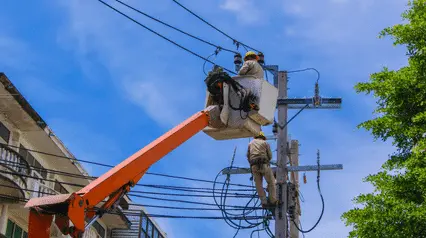What is Switching Energy Suppliers?
Almost everybody in the United States gets their energy from a local utility company. However, in some states, consumers can choose their energy supplier. It is known as energy deregulation or choice. Energy deregulation gives consumers the power to choose their energy provider and the type of energy they want to purchase. For example, consumers can buy renewable energy, such as wind or solar power. In most states, the local utility company still delivers the energy to customers’ homes and businesses. However, in some cases, the consumer may choose an alternate delivery provider.

Energy deregulation has led to competitive energy markets and has given consumers more options regarding their energy needs. It has also resulted in lower electricity prices for consumers. When choosing an energy supplier, it is essential to compare prices and options to find the best deal. Energy deregulation has given consumers more choice and control over their energy bills, an essential tool for saving money on energy costs.
Why Should You Switch Suppliers?

Finding an energy company that offers a plan that best suits your demands is critical, especially if your usage differs from those around you. It may be time to make a change when:
- You’re seeking a fixed-rate energy plan – Is your energy expense varying from one month to the next, or is it unpredictable? Switching to a new energy provider lets you select a fixed-rate plan, which guarantees that your energy supply rate stays constant throughout your contract term.
- You’re seeking a bargain in terms of pricing – Are you searching for a more cost-effective plan that works better with your budget? Switching energy suppliers may allow you to pick a new plan that is more cost-effective or more competitive.
- You’re trying to decrease your carbon impact – Consider obtaining a renewable energy plan if you want to be more environmentally responsible. Many providers now offer such plans at reasonable prices.
- You’re dissatisfied with your existing provider – Are you looking for excellent customer service, alternative plan choices, or anything else? You can compare providers and plans to discover a new energy supplier that meets your needs.
- Your current energy plan no longer works for you – Do you work from home daily? That free time and weekend arrangement may no longer be suitable for you. Are you on a bill credit plan but not using enough electricity to take advantage of the deal? Have your circumstances changed? Have you extended your family or reduced the size of your home? Any of these changes might indicate that it’s time to investigate your alternatives and change energy suppliers.
- You’re looking to qualify for ESOS – If you are a large company in the UK, you may be looking to qualify for Energy Savings Opportunity Scheme (ESOS). This government initiative requires companies to review their energy usage and find ways to improve efficiency. One way to do this is by switching to a new energy supplier that can offer more efficient energy options.
How Do I Choose the Right Energy Provider?
Switching to a new energy supplier is simple, but finding the ideal one may be time-consuming. When selecting a new energy provider, keep these key things in mind:
Check if the Energy Provider is Licensed and Serves Your State
What energy source do you choose: natural gas, electric, solar, or renewable energy options? Know what energy your home requires and whether the firm provides it in your state. Also, see if the price includes any taxes, fees, or other charges. If the supplier offers detailed information, it should be simple to obtain.
Examine Your Current Expenditures
Knowing how much energy costs for your house or small business will help you select an energy provider that meets your needs. Take a look at what you’ve been paying for. Look at your local utility or existing competitive supplier’s most recent statement before comparing other companies’ pricing. Check your bill to see how much you’ve been paying for electricity and natural gas supply.
Consider the Supplier’s Track Record
Is the supplier well established? Do they have a license to operate in your state? If the vendor is permitted to operate in your state, you should be able to locate the license number at your state’s utility commission.
Look for Reputable Customer Service
Look for a business that provides excellent customer service and quick responses to inquiries. Check with your colleagues to see whether they use a particular vendor and how they like it. Follow the company on social media and look at historical patterns to determine whether there are any recurring complaints.
Use Your Judgment to Make Decisions
Find out what other people are paying for their energy supply, and compare it to the rates you’ve been receiving. Find out how much you could save if you switched providers. Check out the costs and plans and the terms and conditions of the coverage you’re thinking about.
Change to Renewable Energy Sources
Many vendors now offer reasonably priced renewable energy plans. If you’re interested in reducing your carbon footprint, consider obtaining a plan from one of these suppliers.

Switching Energy Supplier FAQs
The process of switching electricity suppliers is relatively simple. Simply follow these steps:
- Research different electricity suppliers and compare their rates. Make sure also to read customer reviews to get a sense of the quality of service each company provides.
- Once you’ve chosen a new electricity supplier, contact them and let them know you’d like to switch.
- The new electricity supplier will contact your current supplier to initiate the switch.
- Your current electricity supplier will send you a final bill, which may include a charge for switching providers.
- Once the switch is complete, your new electricity supplier will begin providing your service.
It’s important to note that you may experience a brief lapse in service during the switchover process. However, this is typically not more than a few days.
After switching electricity suppliers, your new supplier will be responsible for providing your service. If you have any questions or problems with your service, you should contact your new supplier directly.
It’s also important to keep an eye on your electricity usage and rates after switching suppliers. Even though you’ve locked in a rate with your new supplier, energy rates can still fluctuate. Your rate could go up or down depending on the market.
To avoid surprises, monitoring your electricity usage and rates closely after switching suppliers is a good idea. This way, you’ll be able to catch any changes and adjust your budget accordingly.
- Rate – You can switch to a provider that offers you a better rate if your energy provider can no longer supply the exact pricing or plans.
- Customer service – When you switch to a new energy supplier, you may notice improved customer care.
- Energy service – Your energy supply will not be interrupted.
- Energy equipment – The distribution and transmission systems will stay preciseness. Physical modifications are unnecessary because your energy is delivered through the same utility-owned and managed transmission and distribution system.
- Energy delivery – Your local electric utility will continue to supply electricity and natural gas, and your delivery expenses will remain the same.
- Billing – Although your electrical usage patterns may vary, you will still be charged by your electric utility for the energy you consume.
- Upkeep – Your energy provider will continue to service all equipment, such as meters, wires, and pipelines, and respond to any power outages.




